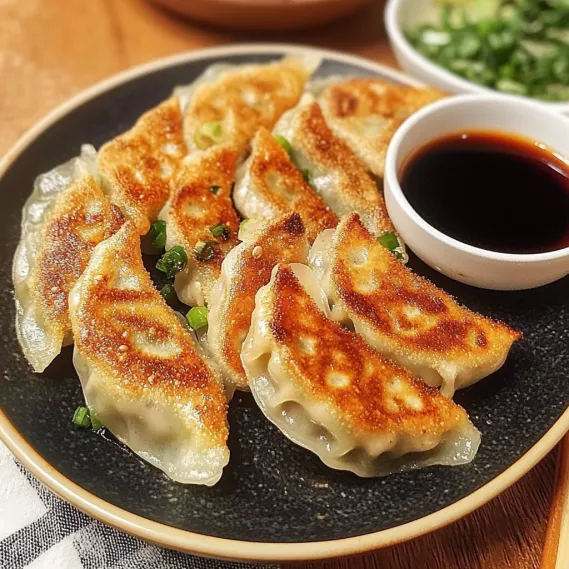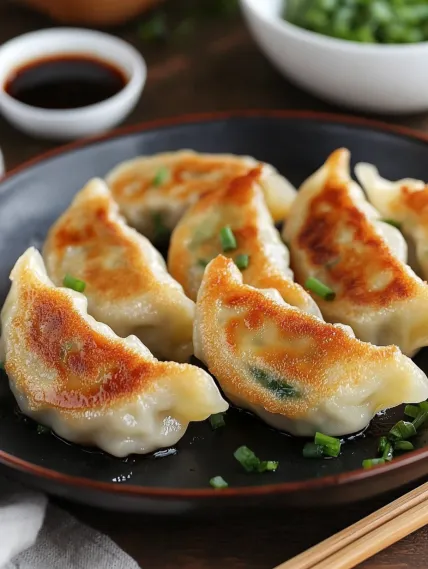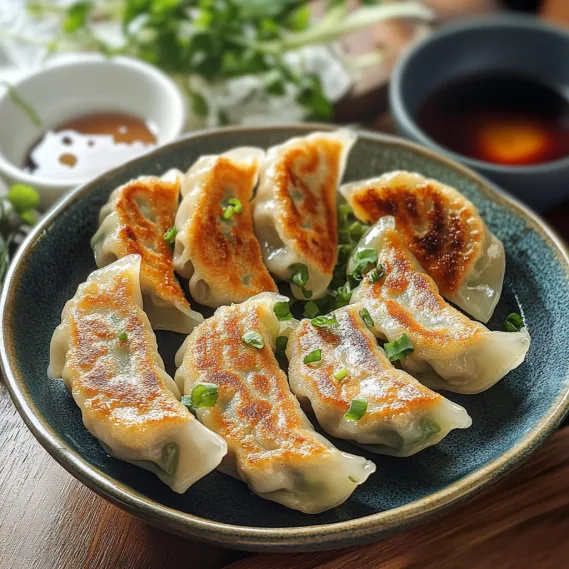 Pin
Pin
Easy homemade Japanese prawn gyoza delivers crispy-bottomed dumplings filled with succulent prawns, fresh cabbage, and aromatic chives. These little parcels of joy offer the perfect contrast between their golden, crispy base and tender, flavorful filling. Each bite bursts with savory umami balanced by the bright dipping sauce. Making these at home brings authentic Japanese flavors to your table with surprisingly simple techniques that yield restaurant-quality results.
I first learned to make these dumplings from my neighbor who lived in Japan for several years. What surprised me most was how something that seemed so complex in restaurants could be created at home with such simple ingredients. The first time I served these at a family gathering, my brother-in-law (who rarely compliments my cooking) asked if I'd ordered takeout from our favorite Japanese restaurant. That's when I knew this recipe was a keeper.
Essential Ingredients and Selection Tips
- Gyoza Wrappers: Made of wheat flour, salt, and water. These are thinner and smaller than Chinese dumpling wrappers. Look for them in the refrigerated section of Asian markets.
- Prawns/Shrimp: Select fresh or frozen prawns, peeled and deveined. If using frozen, ensure they're fully thawed and patted dry before chopping.
- Garlic Chives: These have a unique pungent, garlicky fragrance ideal for dumplings. If unavailable, substitute with regular chives or green onions.
- Cabbage: Asian cabbage or sweetheart cabbage with thin, tender leaves works best. Napa cabbage makes a good substitute.
- Seasonings: The magic comes from the perfect balance of soy sauce, sesame oil, mirin, garlic, and ginger that transforms simple ingredients into something extraordinary.
I've discovered that taking the time to properly squeeze the cabbage makes all the difference in the final texture. The first time I rushed this step, my filling was too wet and caused the wrappers to tear during cooking. Now I ensure the cabbage is as dry as possible before combining with the other ingredients.
Detailed Cooking Instructions
- Step 1: Prepare the Perfect Filling
- Finely chop cabbage and sprinkle with salt, allowing it to sit for 10-15 minutes. Meanwhile, pat dry the prawns and chop them finely with a sharp knife or pulse briefly in a food processor. Squeeze excess moisture from the cabbage with your hands, then combine with prawns and finely chopped chives.
- Step 2: Create Flavor-Packed Mixture
- Add 1 tablespoon soy sauce, 1 tablespoon sesame oil, 1 tablespoon mirin, 2 cloves minced garlic, and 1 teaspoon grated ginger to the prawn mixture. Incorporate 1 tablespoon cornstarch to bind everything together, then mix thoroughly until it becomes slightly sticky and holds together well.
- Step 3: Master the Folding Technique
- Place one gyoza wrapper in your palm, add a tablespoon of filling in the center, and wet the edges with water. Fold the wrapper in half over the filling, then create pleats along one edge by pinching and folding, working from one side to the other while sealing tightly.
- Step 4: Achieve Perfect Pan-Frying
- Heat a tablespoon of oil in a non-stick skillet over medium heat. Place gyoza pleat-side up without touching each other. Cook until bottoms turn golden brown (about 2 minutes), then add 1/3 cup water and immediately cover with a lid. Steam for 3-4 minutes until water evaporates.
- Step 5: Finish with Crispy Perfection
- Once water has evaporated, let gyoza cook uncovered for another minute to crisp up the bottoms. Transfer to a serving plate, crispy-side up, and serve immediately with dipping sauce made from equal parts soy sauce and rice vinegar with a dash of chili oil.

The first time I attempted this recipe, I was intimidated by the folding technique. After several lopsided attempts, I realized that simple pleats work just as well as perfect ones - the flavor remains delicious regardless. Now my children help with the folding, creating their own unique styles that have become part of our family tradition.
The Secret to Perfect Texture
The magic of gyoza lies in their contrasting textures - crispy bottoms and tender tops. I've found that the key to achieving this is controlling moisture at every stage. First, properly squeezing the salted cabbage removes excess water that would otherwise make the filling soggy. Second, the cornstarch not only binds the filling but also absorbs any remaining moisture. Finally, the cooking technique - first frying, then steaming, then frying again - creates that signature crisp bottom while ensuring the filling cooks through perfectly.

Make-Ahead Magic for Entertaining
One of the secrets to an exceptional gyoza is the make-ahead flexibility. I often spend a Sunday afternoon making a double batch, freezing half for later use. Simply arrange uncooked gyoza on a baking sheet lined with parchment paper, freeze until solid, then transfer to freezer bags. They'll keep for up to three months and can be cooked directly from frozen - just add an extra minute to the steaming time. This prep-ahead approach means I can serve impressive homemade dumplings even on busy weeknights or when unexpected guests arrive.
Dipping Sauce Variations
While the classic dipping sauce is delicious, I've experimented with several variations that have become family favorites. For a sweeter option, add a teaspoon of honey to the basic sauce. When serving to spice-lovers, I increase the chili oil and add a dash of Sichuan peppercorns for numbing heat. For a more complex flavor profile, try adding finely minced garlic and a touch of rice vinegar. My personal favorite for summer gatherings includes finely chopped cilantro and a squeeze of lime juice, which brings a refreshing brightness that complements the rich dumplings perfectly.
Perfect Pairing Suggestions
Turn these gyoza into a complete meal with thoughtfully paired sides. For an authentic Japanese experience, serve alongside a simple miso soup and steamed rice. When entertaining, I create an Asian-inspired spread with cucumber salad dressed in rice vinegar, sesame oil, and sugar, plus edamame sprinkled with sea salt. For a fusion approach that's always a hit at parties, serve gyoza alongside Korean kimchi, which provides a spicy counterpoint to the delicate dumpling flavors. The versatility of these dumplings means they work equally well as part of a larger Asian feast or as the star of a simple weeknight dinner.

Chef's Helpful Tips
- For the juiciest filling, chop prawns by hand rather than over-processing them
- If gyoza stick to the pan, wait until they cool slightly - they'll release more easily
- Use a non-stick pan with a tight-fitting lid for the best results
- To create perfectly uniform dumplings, use a small ice cream scoop for measuring filling
- For a professional-looking presentation, arrange gyoza in a circle with their crispy bottoms facing outward
Recipe FAQs
- → Can I freeze these gyoza?
- Yes, place uncooked gyoza on parchment paper in a tray for 1 hour to set, then transfer to a freezer bag for up to 1 month.
- → What's the best way to reheat leftover gyoza?
- Gyoza taste best fresh, but leftovers can be reheated in the microwave for a few seconds until warm.
- → Can I substitute the prawns with something else?
- Ground pork, chicken or finely chopped firm tofu work well as alternatives to prawns in this recipe.
- → Where can I find gyoza wrappers?
- Look for them at Japanese, Chinese or Asian supermarkets, usually in the refrigerated or frozen section.
- → Why do we need to salt the cabbage?
- Salting draws out excess moisture, preventing the filling from becoming too wet and soggy after cooking.
